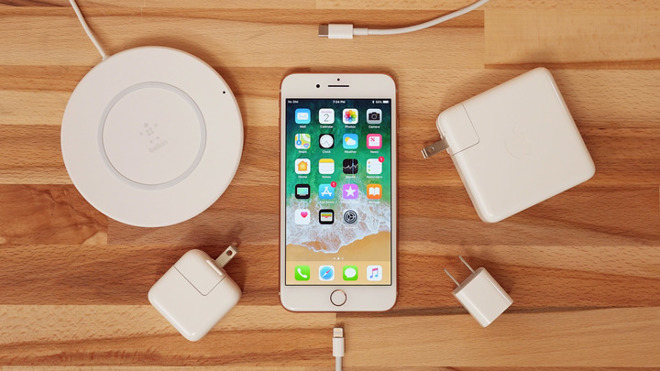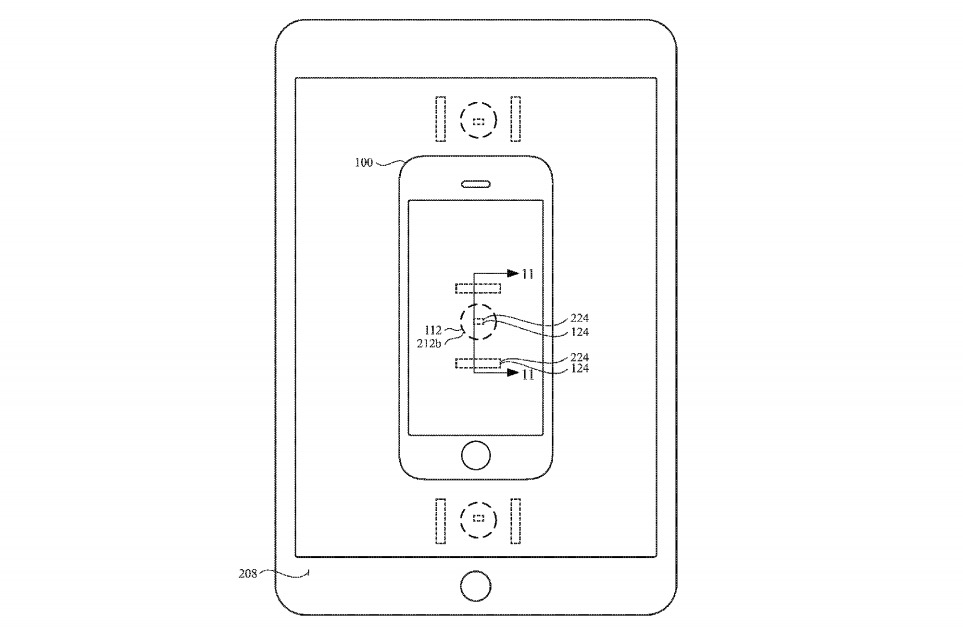Apple has come up with one possible solution to the problem of an iPhone running out of battery while the user's on the move, by taking advantage of wireless charging to transfer power from one mobile device with a fuller battery to another.
A patent application published on Thursday for "Inductive charging between electronic devices" describes ways for two devices, such as a tablet and a smartphone, could recharge each other's batteries using heir existing charge. For example, a drained iPhone battery could be recharged by an iPad with a battery at capacity.
In theory, this would help mobile workers and other users who find some of their devices running out of charge during the day, but also happen to possess other devices that they may not need to use later. This would also reduce the need for users to carry around a charger and cable, as well as having to find an outlet and waiting for charge to be applied.
The application largely centers around the use of inductive coils, which are used to perform wireless charging. Rather than being used in a device just to receive a charge, as seen in current wireless charging systems, Apple proposes the same inductive coils could be used to transmit power as well as to receive.
Images supplied with the patent application suggest an iPhone could be placed in the center of an iPad's display to be recharged, with the iPhone's rear charging coil facing the iPad's screen. In some cases, an alignment magnet could be used to keep the devices in the right orientation for optimal charging.
Some images also propose the use of such coils in notebooks, with drawings of a MacBook seeming to show potential coil positions on the trackpad and to each side. Adding multiple coils to a larger device could allow it to provide charge to multiple smaller mobile devices, which could be useful for anyone wanting to add more charge to an iPhone and an Apple Watch at the same time.
The application also proposes that such a transmission system could also help when charging multiple devices at an outlet. By stacking devices, only one would be needed to connect to the charger, as that primary device could transmit power to others.
Apple does employ wireless charging in some of its products, including the iPhone 8, iPhone X, and Apple Watch. Despite appearing in drawings, the iPad and MacBook lines do not currently provide any wireless charging functionality.
If Apple were to add such a feature to its products, the need for either multiple coils or to set up the coils to be able to switch between receiving and transmitting states means it would require a change in hardware. Current wireless charging devices sold by Apple are unlikely to be retroactively made to transmit power, but it is feasible they could still receive charge in such a system.
Apple applies for a large number of patents on a regular basis. The publication of any applications or granted patents by the U.S. Patent and Trademark Office is not a guarantee that the concepts described will make it to consumer device, if at all.
The "Inductive charging between electronic devices" patent application was filed on March 19, and is a continuation of an earlier similarly-titled patent application from June 2015.
This is not the only patent application Apple has made regarding wireless charging. One from October 2015 suggested using a two-coil inductive charging system that employed coils used for audio and vibratory feedback components, while another from April 2017 explored using a Wi-Fi router for wireless charging.
 Malcolm Owen
Malcolm Owen









-m.jpg)






 Marko Zivkovic
Marko Zivkovic



 Amber Neely
Amber Neely

 Wesley Hilliard
Wesley Hilliard










6 Comments
Leave it to Apple to come up with another ingenious solution.
i would consider this to be ridiculously handy.
Just out of curiosity, but how difficult would it be for Apple to include inductive charging for its mobile devices like the MacBook or MacBook Pro? Would it be worthwhile, and if not, what would it take to make it worthwhile?
I used to have an Mophie battery case for my iPhone I only used for travel.
I was always worried that I would arrive at my destination with low power on my iPhone. (Doesn't seem to be as critical anymore.)I also travelled with an iPad to use on the plane, so I wouldn't drain my iPhone.
Pretty cool idea, Apple! :)
That's just a small step away from a stand-alone Apple (aka WiTricity) device that charges any Apple device close by.